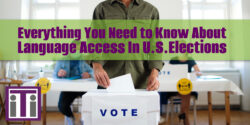One of the biggest trends in education in the last few years has been the expansion of traditional brick and mortar classrooms to the digital world; whether live-streamed to the web, or fully functional courses designed for use online, there has been a huge demand for education to become more accessible.
In the corporate sector in particular, e-learning localization has become a priority, whether for customers or employees. In organizations with thousands of staff, it is essential that training is accessible and can be provided on demand in multiple time zones, and a natural shift has been to offer e-learning modules and courses online.
So:
What do you do if you have a course on company safety policies produced at the United States based company headquarters, and need to ensure everyone in North American, Asian and European satellite offices understands them?
One logical step might be to produce a short digital course on safety along with a brief test at the end of the lesson to verify comprehension and mastery of company safety policies. Some companies might even go a step further and implement a record keeping framework within their Learning Management System to keep track of scores and pass/fail rates of students taking the test.
This still can lead to one central problem – language.
In order to make sure every employee, worldwide, comprehends company safety policy on an equal level, the localization of the e-learning course into the first language of the staff at all company offices would be a logical way to make sure there were no barriers in place preventing access to this critical information.
This can seem like a daunting challenge – creating the content in English was surely an endeavor; does this now mean you need to re-create the content again from scratch into German, Simplified Chinese or maybe even Greek?
Not at all!
Fortunately, the next steps are easy.
We will walk you through the process of having your content localized for your global audience – one central point to understand is that e-learning is a collaborative, all-inclusive medium.
One essential feature of a global e-learning campaign is a partnership with a language services company. You will have a central role helping design the voice, style and appearance of your localized lessons. This is a unique opportunity for your developers to get hands-on and take ownership of global content.
First, there are a few critical questions to answer to determine what kind of content will need to be localized for the e-learning course.
Are there subtitles?
If so, an export of the subtitle file will need to be created, translated, and imported back into the authoring tool used to create the e-learning lesson. Some synchronization or editing work will be needed to make sure the text is being displayed correctly on screen.
Some languages naturally expand and the text flow will potentially need to be edited in order to make sure all content is displayed correctly.
For example, the short phrase in German, “Ich gehe nach Hause,”, means in English, “I go home”. There are four words needed to explain the same concept in German as compared to English.
Does the course include voice-over, a narrator, or both?
If so, voice actors, native in the language the lesson is being translated into, will need to re-record the audio. The original audio file will also need to be replaced with the new translated content.
Some minor edits might be needed to make sure the audio is aligned with transitions in screen, or between slides to make sure it is a mirror copy to the English language original.
You may get the opportunity to listen to several different voice samples and get to choose which will be the best fit for your audience. It would be a smart choice to ask yourself whether your demographic overseas is the same as your United States based audience – maybe your audience in Europe is mostly middle aged and male, while your North American staff are mostly female and under 30. Selecting a voice more closely aligned with that of your audience can improve student attentiveness and interest in the material being presented. You may also have a preference for choosing a very similar voice actor for your localized materials so your organization has a signature style or tone.
Is anyone speaking on screen?
If so, there may need to be some adjustments done in final production of the localized content to make sure that the audio matches exactly with the lip movements of the actors on screen.
Is there text being displayed on screen (besides subtitles)?
If so, this text will need to be extracted, translated, then imported and replaced back on screen and tested to make sure all images are displayed, all slide transitions are intact, and all play-through is correct.
That’s a lot of steps…What comes next?
Once these steps are complete, the e-learning module will need to be loaded back to your website and connected back to your Learning Management System. A final play-through will be needed to verify all content is correct and ready for release.
Two important factors to consider
There are a few items to keep in mind prior with the e-learning localization process, and the most important are:
1. For easy localization, avoid having central features of the video filmed in written text.
For example, a safety protocol with steps 1, 2, 3, written in English and recorded as an actor demonstrates them would be difficult to reproduce without re-filming the video overseas. In some circumstances, for instance, company signage or non-critical written information in the background for instance, ‘cafeteria’, or ‘parking bay’, play less of a central role and would not necessarily lead to a scene needing to be re-recorded.
If you have to introduce written text into the e-learning module, a better option might be to insert text directly into the lesson using your authoring tool, so it can be easily extracted, translated, and replaced. In the event you ever need to make edits to your source file, this also makes the process of incorporating these edits much easier.
2. Depending on the nature of your content, the localization process can take just a few days, or could be as long as weeks.
In order to localize text authored within the e-learning creation tool, a simple extraction can be performed, the text translated, and re-inserted back into the module. Average translation volumes are around 2000 words a day, and the module could be completed within a relatively short time span.
Most subtitles can be extracted just as easily, and the turn around times are typically short.
With dubbing or voice-over, however, a voice actor must be selected, booked, and record the audio content for your file, and any syncing of audio to speakers on screen needs to be performed as a separate step. The expected time to complete this is longer, sometimes weeks, depending on the availability of the actor, length of the audio and amount of re-synchronization work required.
Download our free checklist for preparing for localization of e-learning materials.
About Interpreters and Translators, Inc.
iTi’s dedicated and experienced team offers a wide range of multilingual solutions for domestic and global corporations in a variety of industries. Do you require translation services to enhance your global marketing and sales initiatives or interpreter services to communicate across languages? We specialize in custom language solutions and work with over 200 languages so regardless of the barrier you face, we will work together in synergy to bridge the gap to ensure success. Please feel free to contact us through a message or by calling 860-362-0812. Our offices are open 24/7/365 so we can respond immediately to your interpreting or translation needs anytime, anywhere.







Comments are closed here.